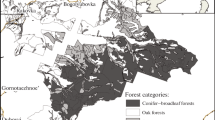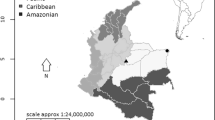Abstract
The aim of this study was to evaluate the influence of forest structure (mainly resulting from human uses) and forest type (the identity of the dominant tree species) on biodiversity. We determined the diversity of two taxonomical groups: the understory vegetation and the edaphic carabid beetle fauna. We selected eight types of forest ecosystems (five replicates or stands per forest type): pine (Pinus sylvestris) plantations of three age classes (10, 40 and 80 years since reforestation), an old-growth relict natural pine forest, and four types of oak (Quercus pyrenaica) stands: mature forests with livestock grazing and firewood extraction, mature forests where uses have been abandoned, “dehesa” ecosystems and shrubby oak ecosystems. The results obtained by a global PCA analysis indicated that both tree size and dominant species influenced the ordination of the 40 forest stands. In general, carabids were more sensitive to changes in forest heterogeneity and responded more clearly to the analysed structural variables than the understory vegetation, although the species richness of both groups was significantly correlated and higher in case of oak forests. Pine forest ecosystems were characterised by the lowest species richness for both taxonomical groups, the lowest plant diversity and by the lowest coefficients of variation and, consequently, low structural heterogeneity. As a result, it was very difficult to discriminate the effects of the spatial heterogeneity and the dominant tree species on biodiversity.

Similar content being viewed by others
References
Augusto L, Dupouey JL, Ranger J (2003) Effects or tree species on understory vegetation and environmental conditions in temperate forests. Ann Sci 60:823–831. doi:10.1051/forest:2003077
Barbier S, Gosselin F, Balandier P (2008) Influence of tree species on understory vegetation diversity and mechanisms involved—a critical review for temperate and boreal forests. For Ecol Manage 254:1–15
Bonham KJ, Mesibov R, Bashford R (2002) Diversity and abundance of some ground-dwelling invertebrates in plantation vs. native forests in Tasmania, Australia. For Ecol Manage 158:237–247
Brockerhoff EG, Berndt LA, Jactel H (2005) Role of exotic pine forests in the conservation of the critically endangered New Zealand ground beetle Holcaspis brevicula (Coleoptera: Carabidae). N Z J Ecol 29:37–43
Brose U (2003) Bottom-up control of carabid beetle communities in early successional wetlands: mediated by vegetation structure or plant diversity? Oecologia 135:407–413
Brunet J, Falkengren-Grerup U, Tyler G (1996) Herb layer vegetation of south Swedish beech and oak forests-effects of management and soil acidity during one decade. For Ecol Manage 88:259–272
Butterfield J, Luff ML, Baines M, Eyre MD (1995) Carabid beetle communities as indicators of conservation potential in upland forests. For Ecol Manage 79:63–77
Campos AM (2003) Estudio de los Carabidae (Coleoptera) de Galicia. Ph.D. Thesis. University of Santiago de Compostela, Spain
Cannell MGR (1999) Environmental impacts of forest monocultures: water use, acidification, wildlife conservation, and carbon storage. New For 17:239–262. doi:10.1023/A:1006551018221
Cottam G, Curtis JT (1956) The use of the distance method in phytosociological sampling. Ecology 37:451–460. doi:10.2307/1930167
Desender K, Ervynck A, Tack G (1999) Beetle diversity and historical ecology of woodlands in Flanders. Belg J Zool 129:139–156
Digweed SC, Currie CR, Cárcamo HA, Spence JR (1995) Digging out the “digging-in effect” of pitfall traps: influences of depletion and disturbance on catches of ground beetles. Pedobiologia (Jena) 39:561–576
du Bus de Warnaffe G, Lebrun P (2004) Effects of forest management on carabid beetles in Belgium: implications for biodiversity conservation. Biol Conserv 118:219–234. doi:10.1016/j.biocon.2003.08.015
Elek Z, Magura T, Tóthmérész B (2001) Impacts of non-native Norway spruce plantation on abundance and species richness of ground beetles (Coleoptera: Carabidae). Web Ecol 2:32–37
Estevan H, Lloret F, Vayreda J, Terradas J (2007) Determinants of woody species richness in Scot pine and beech forests: climate, forest match size and forest structure. Acta Oecol 31:325–331. doi:10.1016/j.actao.2007.01.003
Fahy O, Gormally M (1998) A comparison of plant and carabid beetle communities in an Irish oak woodland with a nearby conifer plantation and clearfelled site. For Ecol Manage 110:263–273
Gracia M, Montané F, Piqué J, Retana J (2007) Overstory structure and topographic gradients determining diversity and abundance of understory shrub species in temperate forests in central Pyrenees (NE Spain). For Ecol Manage 242:391–397
Halme E, Niemelä J (1993) Carabid beetles in fragments of coniferous forest. Ann Zool Fenn 30:17–30
Hartley MJ (2002) Rationale and methods for conserving biodiversity in plantation forests. For Ecol Manage 155:81–95
Humphrey JW, Hawes C, Peace AJ, Ferris-Kaan R, Jukes MR (1999) Relationships between insect diversity and habitat characteristics in plantation forests. For Ecol Manage 113:11–21
Huston MA (1994) Biological diversity. Cambridge University Press, Cambridge
Ings TC, Hartley SE (1999) The effect of habitat structure on carabid communities during the regeneration of a native Scottish forest. For Ecol Manage 119:123–136
Jeannel R (1941–1942) Coléoptères Carabiques. Faune de France, vols. 39 and 40. Lechevalier, Paris
Jukes MR, Peace AJ, Ferris R (2001) Carabid beetle communities associated with coniferous plantations in Britain: the influence of site, ground vegetation and stand structure. For Ecol Manage 148:271–286
Kint V (2005) Structural development in ageing temperate Scots pine stands. For Ecol Manage 214:237–250
Koivula M (2001) Carabid beetles (Coleoptera, Carabidae) in boreal managed forests – meso-scale ecological patterns in relation to modern forestry. Ph.D. Thesis, University of Helsinki, Finland
Koivula M (2002) Alternative harvesting methods and boreal carabid beetles (Coleoptera, Carabidae). For Ecol Manage 167:103–121
Koivula M, Niemelä J (2003) Gap felling as a forest harvesting method in boreal forests: responses of carabid beetles (Coleoptera, Carabidae). Ecography 26:179–187. doi:10.1034/j.1600-0587.2003.03340.x
Koivula M, Punttila P, Haila Y, Niemelä J (1999) Leaf litter and the small-scale distribution of carabid beetles (Coleoptera, Carabidae) in the boreal forest. Ecography 22:424–435. doi:10.1111/j.1600-0587.1999.tb00579.x
Koivula M, Kotze DJ, Hiisivuori L, Rita H (2003) Pitfall trap efficiency: do trap size, collecting fluid and vegetation structure matter? Entomol Fenn 14:1–14
Koricheva J, Mulder CPH, Schmid B, Joshi J, Huss-Danell K (2000) Numerical responses of different trophic groups of invertebrates to manipulations of plant diversity in grasslands. Oecologia 125:271–282. doi:10.1007/s004420000450
Lindroth CH (1974) Handbooks for the identification of British insects. Coleoptera, Carabidae. Royal Entomological Society, London
Lövei GL, Sunderland KD (1996) Ecology and behavior of ground beetles (Coleoptera: Carabidae). Annu Rev Entomol 41:231–256
Luis-Calabuig E, Tárrega R, Calvo L, Marcos E, Valbuena L (2000) History of landscape changes in northwest Spain according to land use and management. In: Trabaud L (ed) Life and environment in the Mediterranean. WIT Press, Southampton, pp 43–86
Lust N, Muys B, Nachtergale L (1998) Increase of biodiversity in homogeneous Scots pine stands by an ecologically diversified management. Biodivers Conserv 7:249–260. doi:10.1023/A:1008892620387
Magura T, Elek Z, Tóthmérész B (2002) Impacts of non-native spruce reforestation on ground beetles. Eur J Soil Biol 38:291–295. doi:10.1016/S1164-5563(02)01162-7
Magurran AE (1989) Diversidad ecológica y su medición. Vedrà, Barcelona
Marcos JA, Marcos E, Taboada A, Tárrega R (2007) Comparison of community structure and soil characteristics in different aged Pinus sylvestris plantations and a natural pine forest. For Ecol Manage 247:35–42
Ministerio de Agricultura (1980) Caracterización agroclimática de la provincia de León. Dirección General de la Producción Agraria, Madrid
Montes F, Sánchez M, Del Río M, Cañellas I (2005) Using historic management records to characterize the effects of management on the structural diversity of forest. For Ecol Manage 207:279–293
Moora M, Daniell T, Kalle H, Liira J, Püssa K, Roosaluste E, Opik M, Wheatley R, Zobel M (2007) Spatial pattern and species richness of boreonemoral forest understorey and its determinants—a comparison of differently managed forests. For Ecol Manage 250:64–70
Moore SE, Allen HL (1999) Plantation forestry. In: Hunter ML Jr (ed) Maintaining biodiversity in forest ecosystems. Cambridge University Press, Cambridge, pp 400–433
Neumann M, Starlinger F (2001) The significance of different indices for stand structure and diversity in forests. For Ecol Manage 145:91–106
Niemelä J (1993) Mystery of the missing species: species-abundance distribution of boreal ground-beetles. Ann Zool Fenn 30:169–172
Niemelä J, Haila Y, Punttila P (1996) The importance of small-scale heterogeneity in boreal forests: variation in diversity in forest-floor invertebrates across the succession gradient. Ecography 19:352–368. doi:10.1111/j.1600-0587.1996.tb00246.x
Onaindía M, Domínguez I, Albizu I, Garbisu C, Amezaga I (2004) Vegetation diversity and vertical structure as indicators of forest disturbance. For Ecol Manage 195:341–354
Ortuño VM, Marcos JM (2003) Los Caraboidea (Insecta: Coleoptera) de la comunidad autónoma del País Vasco. Tomo I. Servicio Central de Publicaciones del Gobierno Vasco, Spain
Pearce JL, Vernier LA (2006) The use of ground beetles (Coleoptera: Carabidae) and spiders (Araneae) as bioindicators of sustainable forest management: a review. Ecol Indic 6:780–793. doi:10.1016/j.ecolind.2005.03.005
Peláez MC (2004) Estudio faunístico, ecológico y biogeográfico de los Carabidae (Coleoptera) del macizo del Sueve (Asturias, España). Ph.D. Thesis, University of León, Spain
Peterken GF (1996) Natural woodland. Ecology and conservation in northern temperate regions. Cambridge University Press, Cambridge
Rainio J, Niemelä J (2003) Ground beetles (Coleoptera: Carabidae) as bioindicators. Biodivers Conserv 12:487–506. doi:10.1023/A:1022412617568
Serrano J (2003) Catálogo de los Carabidae (Coleoptera) de la Península Ibérica. Monografías de la Sociedad Entomológica Aragonesa, vol 9. Zaragoza, Spain
Shannon C, Weaver W (1949) The mathematical theory of communication. University of Illinois Press, Urbana
Spence JR, Niemelä J (1994) Sampling carabid assemblages with pitfall traps: the madness and the method. Can Entomol 126:881–894
Summers RW, Mavor RA, MacLennan AM, Rebecca GW (1999) The structure of ancient native pinewoods and other woodlands in the Highlands of Scotland. For Ecol Manage 119:231–245
Taboada A, Kotze J, Salgado JM, Tárrega R (2006a) The influence of habitat type on the distribution of carabid beetles in traditionally managed dehesa ecosystems in NW Spain. Entomol Fenn 17:280–295
Taboada A, Kotze J, Tárrega R, Salgado JM (2006b) Traditional forest management: do carabid beetles respond to human-created vegetation structures in an oak mosaic landscape? For Ecol Manage 237:436–449
Taboada A, Kotze J, Tárrega R, Salgado JM (2008) Carabids of different-aged reforested pinewoods in a historically modified landscape: do they approach natural forests? Basic Appl Ecol 9:161–171. doi:10.1016/j.baae.2007.01.004
Tárrega R, Calvo L, Marcos E, Taboada A (2006) Forest structure and understory diversity in Quercus pyerenaica communities with different human uses and disturbances. For Ecol Manage 227:50–58
Thomas CFG, Brown NJ, Kendall DA (2006) Carabid movement and vegetation density: implications for interpreting pitfall trap data from split-field trials. Agric Ecosyst Environ 113:51–61. doi:10.1016/j.agee.2005.08.033
Trautner J, Geigenmüller K (1987) Tiger beetles, ground beetles: illustrated key to the Cicindelidae and Carabidae of Europe. Margraf, Germany
Vázquez MG (1990) Estudio faunístico, biogeográfico y ecológico de los Caraboidea (Coleoptera) entre las cuencas de los ríos Bernesga, Torío y Porma (León, España). Ph.D. Thesis, University of León, Spain
Werner SM, Raffa KF (2000) Effects of forest management practices on the diversity of ground-occurring beetles in mixed northern hardwood forests of the Great Lakes region. For Ecol Manage 139:135–155
Wiezik M, Svitok M, Dovciak M (2007) Conifer introductions decrease richness and alter composition of litter-dwelling beetles (Coleoptera) in Carpathian oak forests. For Ecol Manage 247:61–71
Acknowledgments
We thank the Servicio Territorial de Medio Ambiente de la Junta de Castilla y León and several forest guards for collaboration. This study was funded by the C·I.C.Y.T. (Research Project REN 2003-05432/GLO) and by the Junta de Castilla y León (Research Project 2003/25, ref. LE031/03).
Author information
Authors and Affiliations
Corresponding author
Additional information
Communicated by A. Merino and A. Rubio.
This article belongs to the special issue “Plant–soil relationships in Southern European forests”.
Rights and permissions
About this article
Cite this article
Taboada, Á., Tárrega, R., Calvo, L. et al. Plant and carabid beetle species diversity in relation to forest type and structural heterogeneity. Eur J Forest Res 129, 31–45 (2010). https://doi.org/10.1007/s10342-008-0245-3
Received:
Revised:
Accepted:
Published:
Issue Date:
DOI: https://doi.org/10.1007/s10342-008-0245-3




